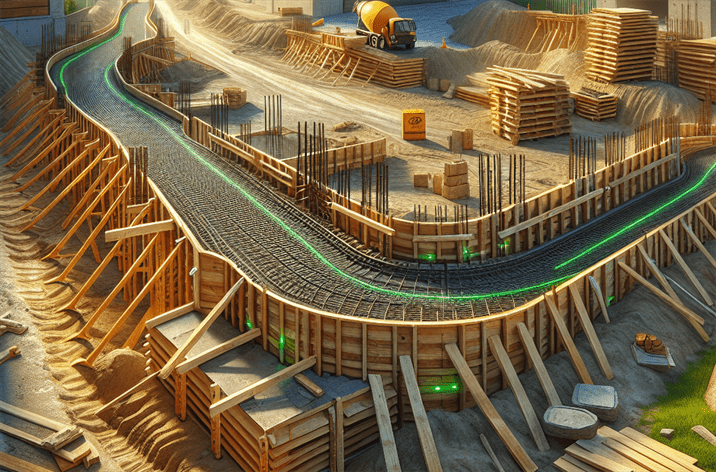Grade Stakes Simplified – A Guide for Every Construction Worker
Introduction
Grade Stakes Simplified: Did you know that grade stakes have been an essential part of construction projects for centuries? These seemingly simple wooden markers are key to ensuring precise measurements and efficient site organization. In today’s complex construction environments, understanding the importance of grade stakes is more crucial than ever to achieve successful project outcomes.
Grade stakes are primarily used to establish the desired elevation and alignment of various structures, from roads to buildings. They help construction workers visualize the layout of the project and ensure that every aspect is executed according to plan. Without these essential tools, projects could quickly veer off course, leading to costly errors and delays.
This article will provide a comprehensive overview of grade stakes, covering their definition, historical context, working principles, benefits, and how to get started with them. Moreover, we will explore the intricacies involved in using grade stakes effectively on the job site. For a deeper understanding of the basics of grade stakes, check out our guide on grade stakes: a simple guide for construction professionals.
What is Grade Stakes Simplified?
Definition
Grade stakes are wooden or metal markers used in construction to define the elevation and layout of a project site. They provide a visual reference for builders and surveyors, ensuring that structures are built to the correct specifications. Typically, grade stakes are placed at key points around the construction area to signal the desired height or depth of the work being done.
Historical Context
The use of stakes in construction dates back to ancient civilizations, where builders relied on basic tools to achieve accuracy. Early civilizations such as the Egyptians and Romans used similar techniques to ensure their monumental structures were built with precision. Over time, as construction methods evolved, so did the tools used, but the fundamental concept of using markers to define space has remained constant.
The Importance of Grade Stakes Simplified
Today, the relevance of grade stakes has only increased, particularly in the face of growing urbanization and complex construction projects. As buildings become taller and sites more intricate, accurate measurements are paramount. Grade stakes help contractors and builders maintain alignment and ensure that every part of the project is constructed according to the approved plans.
Grade Stakes Simplified in the Context of Civil Engineering
In civil engineering, grade stakes are indispensable. They serve as the foundation for planning and executing large-scale projects, such as highways, bridges, and drainage systems. By providing precise elevation markers, they help engineers and construction teams avoid costly mistakes, ensuring that the infrastructure is built to last.
Key Players or Contributors
Organizations such as the American Society of Civil Engineers (ASCE) have emphasized the importance of precision tools, including grade stakes. Innovations in materials and technology have also contributed to the evolution of these tools, making them more durable and effective for modern construction needs.
For more on the role of grade stakes in site planning, see our article on the importance of civil engineering stakes in site planning.

How Does Grade Stakes Simplified Work?
The Mechanics of Grade Stakes Simplified
Using grade stakes on a construction site involves a systematic approach. Here’s a step-by-step breakdown of how they are typically employed:
- Site Preparation: Before placing the stakes, the construction site must be cleared and leveled as much as possible.
- Determining Elevation: A surveyor will determine the desired elevation for the project. This is often based on blueprints or site plans.
- Placing the Stakes: The surveyor will then place grade stakes at various points around the site, marking the required elevation.
- Color Coding: Often, the stakes are color-coded to represent different elevations, making it easier for workers to understand the layout at a glance.
- Verification: Once the stakes are in place, the construction team will verify the measurements to ensure accuracy before commencing work.
- Adjustments: If necessary, stakes can be adjusted or repositioned based on further assessments or changes in the project plan.
- Monitoring: Throughout the construction process, grade stakes serve as ongoing reference points to maintain the intended layout and elevation.
Technological Foundations of Grade Stakes Simplified
In recent years, advancements in technology have revolutionized the way grade stakes are used in construction. Modern surveying equipment, such as total stations and GPS devices, enhance the accuracy of measurements and the placement of stakes. These tools allow surveyors to gather precise data quickly, leading to more efficient site management.
Moreover, digital technology has enabled the creation of software that integrates with surveying equipment, allowing for real-time adjustments to plans based on site conditions. This integration makes the use of grade stakes more effective, as contractors can respond swiftly to any changes or challenges that arise.
Benefits of Using Grade Stakes Simplified
Understanding the benefits of grade stakes can help construction teams appreciate their value in any project. Here are some key advantages:
- Accuracy: Grade stakes ensure that measurements are precise, reducing the likelihood of construction errors.
- Efficiency: Using grade stakes can streamline the construction process, allowing teams to work more quickly and effectively.
- Cost-Effectiveness: By minimizing mistakes, grade stakes can help avoid costly rework and delays, ultimately saving money on the project.
- Enhanced Communication: With clear markers in place, all team members can easily understand the project’s layout, fostering better collaboration and communication.
- Versatility: Grade stakes can be used in various types of construction projects, from residential buildings to large public works.
Challenges in Using Grade Stakes Simplified
While grade stakes offer numerous benefits, there are also challenges that construction teams may face when using them:
- Environmental Conditions: Weather can impact the placement and visibility of grade stakes. Heavy rain or wind can displace stakes, leading to inaccuracies.
- Site Conditions: Uneven or rocky terrain can complicate the placement of stakes, requiring additional adjustments and time.
- Human Error: Misinterpretation of stake placements or elevations can lead to costly mistakes, so proper training and communication are essential.
- Maintenance: Regular checks are necessary to ensure that stakes remain in the correct position throughout the construction process.
Getting Started with Grade Stakes Simplified
Best Practices for Using Grade Stakes Simplified
To maximize the benefits of grade stakes, consider the following best practices:
- Proper Training: Ensure that all team members involved in the project understand how to use and interpret grade stakes accurately.
- Regular Checks: Frequently verify the placement and condition of the stakes, especially after adverse weather conditions.
- Use Quality Materials: Invest in durable materials for stakes to ensure they withstand environmental challenges.
- Documentation: Keep detailed records of stake placements and elevations to facilitate communication and project tracking.
- Adaptability: Be prepared to make adjustments as the project progresses, as site conditions may change.
- Technology Integration: Utilize modern surveying tools to enhance accuracy and efficiency in stake placement.
For comprehensive insights on how to effectively use stakes for construction, explore our article on best practices for using stakes and lath in construction.
Future Trends in Grade Stakes Simplified
As the construction industry continues to evolve, several trends may shape the future of grade stakes:
- Increased Use of Technology: The integration of technology in construction processes will continue to grow, making grade stakes even more accurate and easier to use.
- Sustainability: With a growing emphasis on sustainable construction practices, there will be a push for eco-friendly materials in the production of grade stakes.
- Automation: The potential for automated systems to manage stake placement could further enhance accuracy and efficiency on construction sites.
- Training and Education: As technology advances, ongoing education for construction professionals regarding the best practices for using grade stakes will become increasingly important.
Conclusion
In conclusion, grade stakes are a fundamental aspect of construction that cannot be overlooked. Their role in ensuring accurate measurements and effective site organization is crucial for the success of any project. By understanding their historical context, mechanics, benefits, and best practices, construction workers can harness the full potential of these tools to enhance their workflow.
As construction methods evolve, staying informed about the latest trends and technologies surrounding grade stakes will empower professionals to execute their projects with precision and efficiency. For more insights into the advantages of using grade stakes, consider reading our article on the essential role of surveying stakes in construction projects.
With the right knowledge and tools, every construction worker can achieve success through the effective use of grade stakes.
Resource Links:
1. Construction Knowledge – A comprehensive guide explaining the use of grade stakes in construction projects, focusing on practical applications for workers.
2. The Balance Small Business – An informative article detailing the importance of grade stakes in construction, along with step-by-step instructions for implementation.
3. Construction Dive – An exploration of the role of grade stakes in ensuring accuracy in construction sites, featuring expert insights and best practices.

